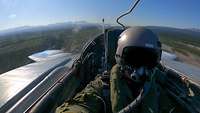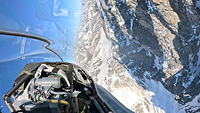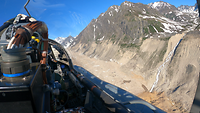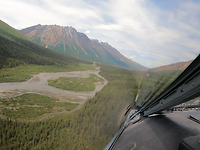The challenges of very-low-level flying
Technology- Date:
- Place:
- Alaska
- Reading time:
- 3 MIN


The very-low-level flight exercise of German Tornado combat aircraft during the Pacific Skies 24 deployment in Alaska requires not only concentration but also skill. Thorough preparation helps pilots in these situations. However, the fight against their own instincts is stronger than expected.

An exact planning and an approach with a cool head are crucial for the lowest flight
Bundeswehr/LuftwaffeEach flight can be divided into four phases:
1. Mission planning
During this phase, a plan for the flight is prepared. Information is collected and evaluated. It is essential to evaluate the training area and then plan the flight route – this is done by the crew themselves. In the specified sections, possible obstacles such as buildings, vegetation, mountains etc. are taken into account. In order for the pilots to be able to navigate safely, it is essential to use a flight route that is as precise as possible. The crew internalizes the route and prepares procedures for unexpected events.
2. Briefing
The briefing is a pre-flight meeting with all involved parties. All the collected information will be shared again so that everyone has the same state of knowledge. Factors along the routes such as wind and weather, which depend on the day, are important. The well-being of the pilots and the condition of the aircraft are also checked so that all possible sources of error can be identified in advance and, if possible, eliminated.
3. Flying
Flying is the shortest of the four phases because detailed preparation is crucial and takes more time. Here, theoretical knowledge is translated into practical skills. In this phase, aviation skills and experience with the weapon system are needed.
4. Debriefing
The debriefing is used to evaluate the flight. Did everything go as expected? What worked well, what went wrong? This information can be helpful for future flights and to improve procedures.
Safety takes the highest priority in all phases. Straight flight is not dangerous, but changing the direction of flight is. At a speed of about 850 km/h at an altitude of about 30 meters, there is hardly any time left to react if something has been overlooked during planning. Treetops, birds and here in Alaska the mountains – everything has to be considered. Therefore, a detailed briefing is crucial to minimize potential hazards. The saying "Five minutes of preparation save one hour of execution" also applies in aviation.

Not only concentration, but also skill are needed during a low flight, when mountains and nature are getting closer and closer
Bundeswehr/LuftwaffeBut not everything can be planned for by thorough preparation. Human instincts are strong. During low-level flying, for example trees give clues as to how fast you are moving. This is unusual, as such orientation points are missing in the air. Humans tend to want to avoid this situation, which they perceive as dangerous. This is due to our survival instinct and respect for the risks. The preferred course of action would be to gain altitude. Discipline is required to fight this instinct and to continue on the flight route. Leaving the planned route may have consequences. That is why precise planning and a cool-headed approach are crucial.
"Chair flying" can be helpful in this situation. During the preparation, the route and the procedure are mentally rehearsed and thus internalized. Only factors such as g-forces, winds, radio messages or noises are missing. This can also be discussed in the group – there are many variations. Such technique is also used by competitive athletes or in Formula 1 to prepare accordingly. As a result, you no longer have to think about what you are doing, but you have time to think about the how and to execute it. Ultimately, chair flying helps to bring structure into flying for different situations. It saves vital seconds in real flight operations. However, a certain respect for the dangers remains and ultimately keeps the pilots and their weapon system officers alive. Instincts with healthy origins.

At about 850 kilometers per hour at an altitude of about 30 meters, there is hardly any time to react if something was overlooked in the planning. That's why concentration is needed.
Bundeswehr/Luftwaffe
The routes of a flight are planned in the specified sections of the exercise area and flown as accurately as possible
Bundeswehr/Luftwaffe